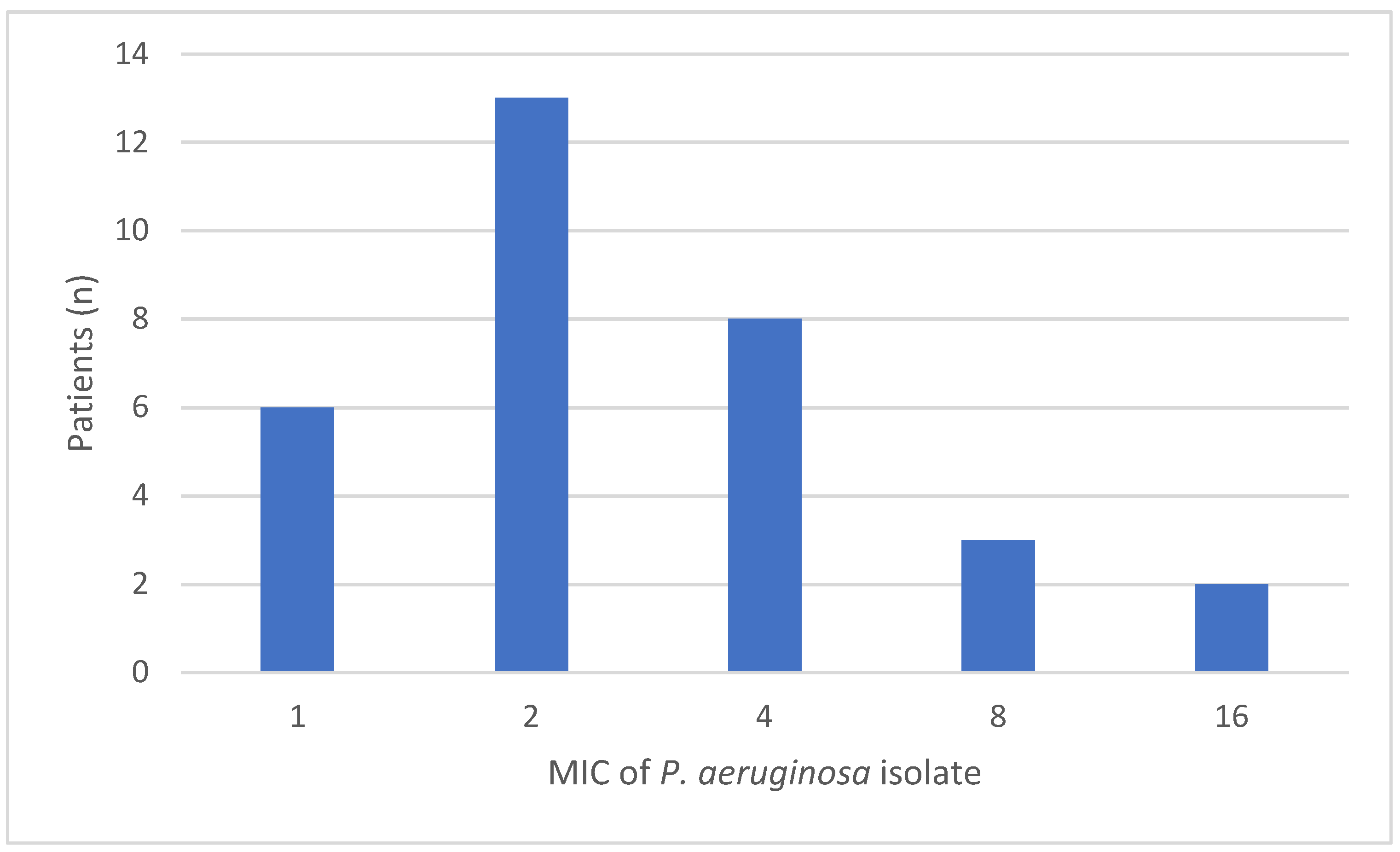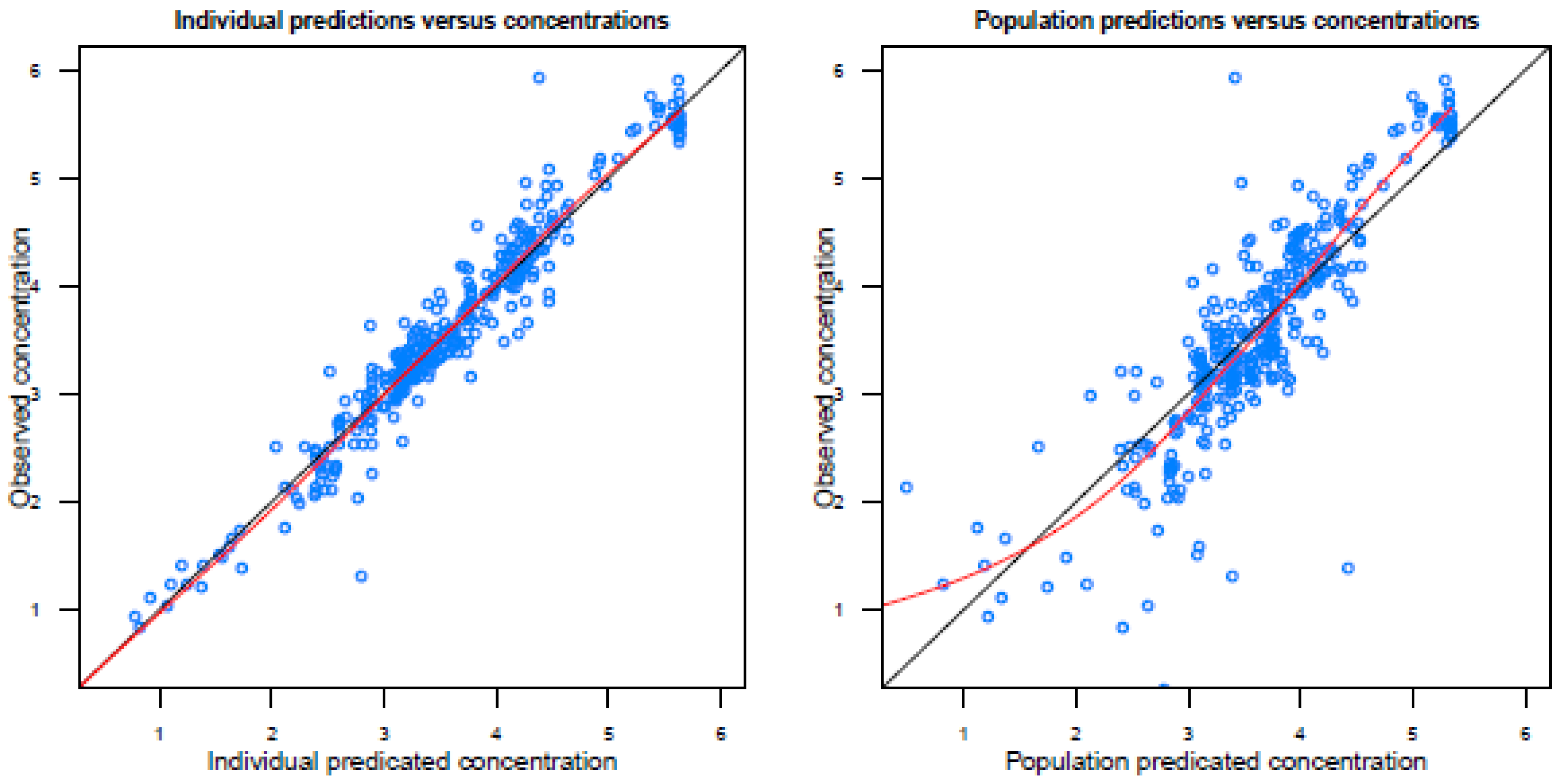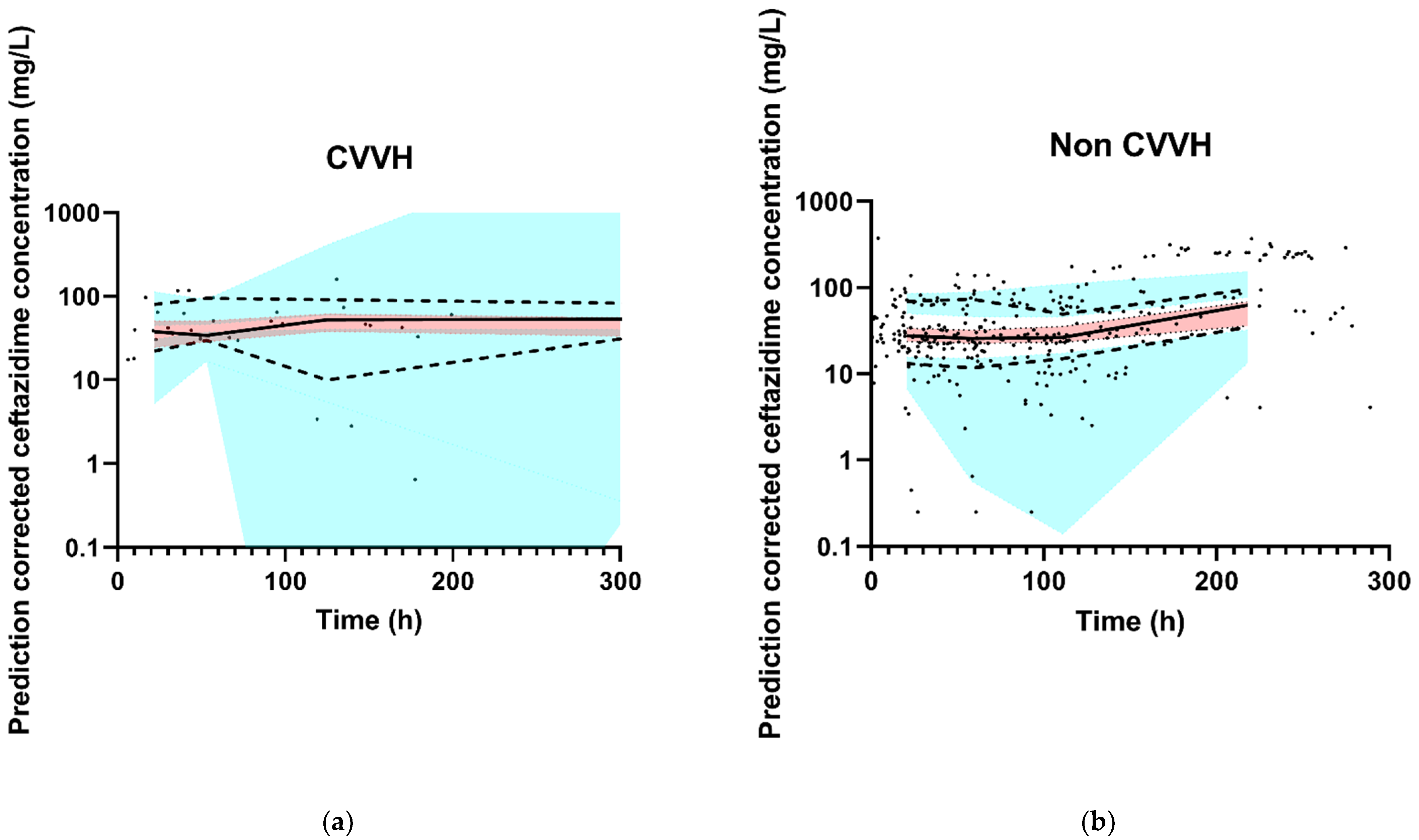Population Pharmacokinetics and Probability of Target Attainment of Different Dosing Regimens of Ceftazidime in Critically Ill Patients with a Proven or Suspected Pseudomonas aeruginosa Infection
Abstract
1. Introduction
2. Results
2.1. Patients and Ceftazidime Concentrations
2.2. Population Pharmacokinetic Analysis
2.3. PK/PD Target Attainment
2.4. Monte Carlo Dosing Simulations
2.5. Clinical Outcome Measures: Microbiological and Clinical Cure
3. Discussion
4. Materials and Methods
4.1. Study Design and Setting
4.2. Study Population
4.3. Outcome Measures
4.4. Sample and Data Collection
4.5. Drug Assay and Isolates
4.6. Population Pharmacokinetic Analysis
4.7. Monte Carlo Simulations
4.8. Statistical Analysis
5. Conclusions
Author Contributions
Funding
Institutional Review Board Statement
Informed Consent Statement
Data Availability Statement
Conflicts of Interest
Appendix A. Results: MIC Distribution

Appendix B. Results: Goodness-of-Fit Plots


Appendix C. Results: NONMEM Control Stream
| $PROBLEM PK model $INPUT AORTA ID DROP DROP TIME TAD AMT RATE DROP DV MDV EVID OCC DROP DROP DROP DROP DROP DROP CVVH DROP DROP DROP DROP COMO DROP DROP DROP DROP CKD $DATA 28.csv IGNORE = #; $SUBROUTINES ADVAN1 TRANS2 $PK FLAT1 = 0 FLAT2 = 0 IF(COMO.EQ.1) FLAT1 = 1 IF(COMO.EQ.3) FLAT2 = 1 IF(COMO.EQ.4) FLAT2 = 1 IF(CVVH.EQ.0) THEN CL = THETA(2)*(CKD/73)**THETA(5)*THETA(6)**(FLAT1)*THETA(7)**(FLAT2)*EXP(ETA(1)) ELSE CL = THETA(4) ENDIF V = THETA(3) * EXP(ETA(2)) S1 = V $THETA 0.281 ;1 proportional error 3.42 ;2 CL non CVVH 46.8 ;3 V 2.9 ;4 CL CVVH 0.772 ;5 CKD on CL nonCVVH 1.57 ;6 factor COMO CAT1 (hematologic malignancy) on Cl 1.99 ;7 factor COMO CAT3 (trauma) + CAT4 (brain injury) on Cl $OMEGA 0.122 ;1 IIV CL NON CVVH 0.721 ;2 IIV V $SIGMA 1 FIX ;residual variability $ERROR ERR1 = SQRT(THETA(1)**2) IPRED = −3 IF(F.GT.0) IPRED = LOG(F) Y = IPRED + ERR1*EPS(1) IRES = DV-IPRED IWRES = IRES/ERR1 $EST METHOD = 1 INTERACTION MAXEVAL = 9999 SIG = 3 PRINT = 5 NOABORT POSTHOC $COV PRINT = E UNCONDITIONAL $TABLE ID TIME DV MDV EVID IPRED IWRES TAD AMT CWRES CL V ETA1 ETA2 OCC CVVH CKD COMO NOPRINT ONEHEADER FILE = sdtab83a |
Appendix D. Methods: Population Pharmacokinetic Analysis
References
- Horino, T.; Chiba, A.; Kawano, S.; Kato, T.; Sato, F.; Maruyama, Y.; Nakazawa, Y.; Yoshikawa, K.; Masaki, Y.; Hori, S. Clinical characteristics and risk factors for mortality in patients with bacteremia caused by Pseudomonas aeruginosa. Int. Med. 2012, 51, 59–64. [Google Scholar] [CrossRef][Green Version]
- Kang, C.I.; Kim, S.H.; Kim, H.B.; Park, S.W.; Choe, Y.J.; Oh, M.D.; Kim, E.C.; Choe, K.W. Pseudomonas aeruginosa Bacteremia: Risk Factors for Mortality and Influence of Delayed Receipt of Effective Antimicrobial Therapy on Clinical Outcome. Clin. Infect. Dis. 2003, 51, 745–751. [Google Scholar] [CrossRef] [PubMed]
- Dantas, R.C.; Ferreira, M.L.; Gontijo-Filho, P.P.; Ribas, R.M. Pseudomonas aeruginosa bacteraemia: Independent risk factors for mortality and impact of resistance on outcome. J. Med. Microbiol. 2014, 63, 1679–1687. [Google Scholar] [CrossRef] [PubMed]
- Eklöf, J.; Gliese, K.; Ingebrigtsen, T.; Bodtger, U.; Jensen, J. Antibiotic treatment adequacy and death among patients with Pseudomonas aeruginosa airway infection. PLoS ONE 2019, 14, e0226935. [Google Scholar] [CrossRef] [PubMed]
- MacArthur, R.D.; Miller, M.; Albertson, T.; Panacek, E.; Johnson, D.; Teoh, L.; Barchuk, W. Adequacy of early empiric antibiotic treatment and survival in severe sepsis: Experience from the MONARCS trial. Clin. Infect. Dis 2004, 38, 284. [Google Scholar] [CrossRef] [PubMed]
- Abdul-Aziz, M.H.; Alffenaar, J.W.; Bassetti, M.; Bracht, H.; Dimopoulos, G.; Marriott, D.; Neely, M.N.; Paiva, J.A.; Pea, F.; Sjovall, F.; et al. Antimicrobial therapeutic drug monitoring in critically ill adult patients: A Position Paper. Intensive Care Med. 2020, 46, 1127–1153. [Google Scholar] [CrossRef] [PubMed]
- Jager, N.G.L.; Van Hest, R.M.; Lipman, J.; Taccone, F.S.; Roberts, J.A. Therapeutic drug monitoring of anti-infective agents in critically ill patients. Expert Rev. Clin. Pharm. 2016, 9, 961–979. [Google Scholar] [CrossRef] [PubMed]
- Goncalves-Pereira, J.; Povoa, P. Antibiotics in critically ill patients: A systemic review of the pharmacokinetics of β-lactams. Crit. Care 2011, 15, R206. [Google Scholar] [CrossRef] [PubMed]
- Roberts, J.A.; Sanjoy, K.P.; Akova, M.; Bassetti, M.; De Waele, J.J.; Dimopoulos, G.; Kaukonen, K.M.; Koulenti, D.; Martin, C.; Montravers, P.; et al. DALI: Defining antibiotic levels in intensive care unit patients doses sufficient for critically ill patients. Clin. Infect. Dis. 2014, 58, 1072–1083. [Google Scholar] [CrossRef]
- Benko, A.S.; Cappelletty, D.M.; Kruse, J.A.; Rybak, M.J. Continuous infusion versus intermittent administration of ceftazidime in critically ill patients with suspected gram-negative infections. Antimicrob. Agents Chemother. 1996, 40, 691–695. [Google Scholar] [CrossRef] [PubMed]
- Mouton, J.; Punt, N.; Vinks, A.A. A retrospective analysis using monte carlo simulation to evaluate recommended ceftazidime dosing regimens in healthy volunteers, patients with cystic fibrosis, and patients in the intensive care unit. Clin. Ther. 2005, 27, 762–772. [Google Scholar] [CrossRef] [PubMed]
- Hanes, S.D.; Wood, G.C.; Herring, V.; Croce, M.A.; Fabian, T.C.; Pritchard, E.; Boucher, B.A. Intermittent and continuous ceftazidime infusion for critically ill trauma patients. Am. J. Surg. 2000, 179, 436–440. [Google Scholar] [CrossRef]
- Mouton, J.; den Hollander, J. Killing of Pseudomonas aeruginosa during continuous and intermittent infusion of ceftazidime in an in vitro pharmacokinetic model. Antimicrob. Agents Chemother. 1994, 38, 931–936. [Google Scholar] [CrossRef] [PubMed]
- Mouton, J.; Vinks, A. Is continuous infusion of β-lactam antibiotics worthwhile? Efficacy and pharmacokinetic considerations. J. Antimicrob. Chemother. 1996, 38, 5–15. [Google Scholar] [CrossRef] [PubMed]
- Young, R.; Lipman, J.; Oh, T. Intermittent bolus dosing of ceftazidime in critically ill patients. J. Antimicrob. Chemother. 1997, 40, 269–273. [Google Scholar] [CrossRef] [PubMed][Green Version]
- Delattre, I.; Musuamba, F.; Jacqmin, P.; Taccone, F.S.; Laterre, P.F.; Verbeeck, R.K.; Jacobs, F.; Wallemacq, P. Population pharmacokinetics of four β-lactams in critically ill septic patients comedicated with amikacin. Clin. Biochem. 2012, 45, 780–786. [Google Scholar] [CrossRef] [PubMed]
- Frame, B.C.; Facca, B.F.; Nicolau, D.P.; Triesenberg, S.N. Population pharmacokinetics of continuous infusion ceftazidime. Clin. Pharm. 1999, 37, 343–350. [Google Scholar] [CrossRef]
- Gomez, C.; Cordingly, J.; Palazzo, M. Altered pharmacokinetics of ceftazidime in critically ill patients. Antimicrob. Chemother. 1999, 43, 1798–1802. [Google Scholar] [CrossRef]
- McKinnon, P.S.; Paladino, J.A.; Schentag, J.J. Evaluation of area under the inhibitory curve (AUIC) and time above the minimum inhibitory concentration (T > MIC) as predictors of outcome for cefepime and ceftazidime in serious bacterial infections. Int. J. Antimicrob. Agents 2008, 31, 345–351. [Google Scholar] [CrossRef]
- Roberts, J.A.; De Waele, J.J.; Dimopoulos, G.; Koulenti, D.; Martin, C.; Montravers, P.; Rello, J.; Rhodes, A.; Starr, T.; Wallis, S.C.; et al. DALI: Defining Antibiotic Levels in Intensive care unit patients: A multi-centre point of prevalence study to determine whether contemporary antibiotic dosing for critically ill patients is therapeutic. BMC Infect. Dis. 2012, 12, 152. [Google Scholar] [CrossRef] [PubMed]
- Wong, G.; Brinkman, A.; Benefield, R.J.; Carlier, M.; De Waele, J.J.; El Helali, N.; Frey, O.; Harbarth, S.; Huttner, A.; McWhinney, M.B.; et al. An international, multicentre survey of β-lactam antibiotic therapeutic drug monitoring practice in intensive care units. J. Antimicrob. Chemother. 2014, 69, 1416–1423. [Google Scholar] [CrossRef] [PubMed]
- Udy, A.A.; Roberts, J.A.; Boots, R.J.; Paterson, D.L.; Lipman, J. Augmented renal clearance: Implications for antibacterial dosing in the critically ill. Clin. Pharm. 2010, 49, 1–16. [Google Scholar] [CrossRef] [PubMed]
- Akers, K.S.; Niece, K.L.; Chung, K.K.; Cannon, J.W.; Cota, J.M.; Murray, C.K. Modified Augmented Renal Clearance score predicts rapid piperacillin and tazobactam clearance in critically ill surgery and trauma patients. J. Trauma Acute Care Surg. 2014, 77, S163–S170. [Google Scholar] [CrossRef] [PubMed]
- Baptista, J.P.; Sousa, E.; Martins, P.J.; Pimentel, J.M. Augmented renal clearance in septic patients and implications for vancomycin optimisation. Int. J. Antimicrob. Agents. 2012, 39, 420–423. [Google Scholar] [CrossRef] [PubMed]
- Gatti, M.; Raschi, E.; de Ponti, F. Serious adverse events with novel beta-lactam/beta-lactamase inhibitor combinations: A large pharmacovigilance analysis. Eur. J. Clin. Microbiol. 2021. [Google Scholar] [CrossRef] [PubMed]
- Carmeli, Y.; Troillet, N.; Eliopoulos, G.M.; Samore, M.H. Emergence of antibiotic-resistant Pseudomonas aeruginosa: Comparison of risks associated with different antipseudomonal agents. Antimicrob. Agents Chemother. 1999, 43, 1379–1382. [Google Scholar] [CrossRef] [PubMed]
- Ong, D.S.Y.; Jongerden, I.P.; Buiting, A.G.; Leverstein-van Hall, M.A.; Speelberg, B.; Kesecioglu, J.; Bonten, M.J.M. Antibiotic exposure and resistance development in Pseudomonas aeruginosa and Enterobacter species in intensive care units. Crit. Care Med. 2011, 39, 2458–2463. [Google Scholar] [CrossRef] [PubMed]
- Robbert, S.; Zarowitz, B.J.; Peterson, E.L.; Dumler, F. Predictability of creatinine clearance estimates in critically ill patients. Crit. Care Med. 1993, 21, 1487–1495. [Google Scholar] [CrossRef]
- European Committee on Antimicrobial and Susceptibility Testing. Clinical Breakpoints. Available online: http://www.eucast.org/clinical_breakpoints (accessed on 8 March 2021).
- Beal, S. Ways to fit a PK model with some data below the quantification limit. J. Pharm. Pharm. 2002, 28, 481–504. [Google Scholar]





| Characteristic | Median [Range] |
|---|---|
| Female, n (%) | 38 (40%) |
| Age, yrs | 59 [20–84] |
| Body weight, kg | 79 [44–237] |
| Body mass index, kg/m2 | 25 [16–66] |
| Ceftazidime dose prescribed in the first 24 h, n (%) | |
| 1 g tid | 7 (7%) |
| 2 g tis | 3 (3%) |
| <3 g continuous infusion | 1 (1%) |
| 3 g continuous infusion | 34 (35%) |
| 3–5 g continuous infusion | 11 (11%) |
| 5 g continuous infusion | 25 (25%) |
| 6 g continuous infusion | 9 (9%) |
| Other | 6 (%) |
| Loading dose, n (% of patients with continuous infusion) | 65 (81%) |
| SOFA score at start of ceftazidime therapy (n = 64) c | 10 [4–16] |
| 30-day mortality, n (%) | 37 (39%) |
| Primary infection site, n(%) | |
| Pneumonia | 37 (39%) |
| Bloodstream | 17 (18%) |
| Abdominal infection | 13 (14%) |
| Meningitis | 22 (23%) |
| Other | 7 (7%) |
| Admission Category, n (%) | |
| Medical | 54 (56%) |
| Surgical | 42 (44%) |
| Comorbidity, n (%) | |
| Hematologic malignancy | 14 (15%) |
| Oncologic malignancy | 12 (13%) |
| Trauma or head injury | 27 (28%) |
| Other | 43 (45%) |
| Vasopression, n (%) | 66 (69%) |
| Ventilation, n (%) | 74 (77%) |
| Creatinine, mg/dL | 0.98 [0.19–7.49] |
| eGFR a, mL/min/m2 | 73 [6–153] |
| CVVH, n (%) b | 20 (21%) |
| RIFLE score, n (%) | |
| No AKI | 62 |
| Stage 1 | 4 |
| Stage 2 | 1 |
| Stage 3 | 29 |
| Mean Inhibitory concentration (mg/L) P. aeruginosa at start therapy, n (%) | |
| 1 | 6 (19%) |
| 2 | 13 (40%) |
| 4 | 8 (25%) |
| 8 | 3 (9%) |
| 16 | 2 (6%) |
| Structural Model | Final Model | Bootstrap # | ||||
|---|---|---|---|---|---|---|
| Estimation | RSE (%) | Estimation | RSE (%) | Estimation | 95% CI | |
| CL CVVH (L/h) | 2.82 | 11 | 2.9 | 11 | 2.88 | 2.18–3.47 |
| CL non CVVH (L/h) | 4.56 | 9 | 3.42 | 9 | 3.46 | 2.88–4.04 |
| V (L) | 47.6 | 13 | 46.8 | 12 | 46.7 | 37.5–59.5 |
| Proportional error | 0.288 | 12 | 0.281 | 12 | 0.277 | 0.216–0.352 |
| IIV | ||||||
| CL non CVVH (CV%) | 103.4 | 11 | 36.0 | 14 | 35.3 | 24.7–46.8 |
| V (CV%) | 84.7 | 15 | 102.8 | 18 | 100.1 | 59.8–160.0 |
| Covariate effects | ||||||
| CKD-EPI | - | - | 0.772 a | 11 | 0.788 | 0.655–1.022 |
| Comorbidity hematologic malignancy | - | - | 1.57 | 17 | 1.54 | 1.07–2.15 |
| Comorbidity trauma or head injury | - | - | 1.99 | 13 | 1.96 | 1.51–2.55 |
| Secondary Endpoints | Definition |
|---|---|
| 100% T > MIC | Ceftazidime concentration maintained above MIC of the pathogen throughout ≥95% of the first 24 h of treatment. |
| 100% T > 4 × MIC | Ceftazidime concentration maintained above a concentration 4-fold higher than the MIC of the pathogen throughout ≥95% of the first 24 h of treatment. |
| Microbiological response: assessed between 48 h after start of therapy until 48 h after stop of therapy | |
| Patients with microbiological cure. | P. aeruginosa cultures become negative during or after ceftazidime treatment. |
| Patients with microbiological failure without decreased susceptibility for ceftazidime. | P. aeruginosa cultures (from the same or relevant location) remain positive during ceftazidime treatment, MIC remains equal. |
| Patients with microbiological failure with decreased susceptibility (resistance) for ceftazidime. | P. aeruginosa cultures (from the same or relevant location) remain positive during ceftazidime treatment, MIC increases with at least factor 4. |
| Clinical response | |
| Clinical cure | Completion of full treatment course without change or addition of antibiotic therapy, and no additional antibiotics commenced within 48 h of cessation. |
| Clinical failure | Any clinical outcome other than clinical cure. |
Publisher’s Note: MDPI stays neutral with regard to jurisdictional claims in published maps and institutional affiliations. |
© 2021 by the authors. Licensee MDPI, Basel, Switzerland. This article is an open access article distributed under the terms and conditions of the Creative Commons Attribution (CC BY) license (https://creativecommons.org/licenses/by/4.0/).
Share and Cite
Werumeus Buning, A.; Hodiamont, C.J.; Lechner, N.M.; Schokkin, M.; Elbers, P.W.G.; Juffermans, N.P.; Mathôt, R.A.A.; de Jong, M.D.; van Hest, R.M. Population Pharmacokinetics and Probability of Target Attainment of Different Dosing Regimens of Ceftazidime in Critically Ill Patients with a Proven or Suspected Pseudomonas aeruginosa Infection. Antibiotics 2021, 10, 612. https://doi.org/10.3390/antibiotics10060612
Werumeus Buning A, Hodiamont CJ, Lechner NM, Schokkin M, Elbers PWG, Juffermans NP, Mathôt RAA, de Jong MD, van Hest RM. Population Pharmacokinetics and Probability of Target Attainment of Different Dosing Regimens of Ceftazidime in Critically Ill Patients with a Proven or Suspected Pseudomonas aeruginosa Infection. Antibiotics. 2021; 10(6):612. https://doi.org/10.3390/antibiotics10060612
Chicago/Turabian StyleWerumeus Buning, Annabel, Caspar J. Hodiamont, Natalia M. Lechner, Margriet Schokkin, Paul W. G. Elbers, Nicole P. Juffermans, Ron A. A. Mathôt, Menno D. de Jong, and Reinier M. van Hest. 2021. "Population Pharmacokinetics and Probability of Target Attainment of Different Dosing Regimens of Ceftazidime in Critically Ill Patients with a Proven or Suspected Pseudomonas aeruginosa Infection" Antibiotics 10, no. 6: 612. https://doi.org/10.3390/antibiotics10060612
APA StyleWerumeus Buning, A., Hodiamont, C. J., Lechner, N. M., Schokkin, M., Elbers, P. W. G., Juffermans, N. P., Mathôt, R. A. A., de Jong, M. D., & van Hest, R. M. (2021). Population Pharmacokinetics and Probability of Target Attainment of Different Dosing Regimens of Ceftazidime in Critically Ill Patients with a Proven or Suspected Pseudomonas aeruginosa Infection. Antibiotics, 10(6), 612. https://doi.org/10.3390/antibiotics10060612






